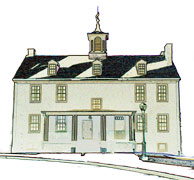




 | | | ||
 | | |||
 | | | | |
 | | |||
 | | |||
| TRANSPORTATION During the late 1820s agitation began for a railroad from Philadelphia to open up the western portions of Pennsylvania for development and to provide competition for New York State's Erie Canal. The first portion of the Philadelphia and Columbia Railroad opened in 1832 and was part of the Main Line of Public Works, a cumbersome series of railroads, inclined planes, and canals that spanned the width of the state. The "Main Line" portion of the name stuck and eventually came to refer to the territory between Overbrook and Paoli. The Pennsylvania Railroad later took over the Philadelphia and Columbia, with stations in Lower Merion at Merion, Narberth (Narberth village became a borough in 1895), Wynnewood, Ardmore, Haverford, Bryn Mawr, and Rosemont. Eventually turning into a four-track electrified line, the railroad became one of the busiest in the nation. In 1980 it was still the heaviest traveled of the region's commuter lines. The Reading Railroad's predecessors opened a rail line along the west bank of the Schuylkill in 1839, running through West Manayunk (now Belmont Hills) and Gladwyne. Passenger trains operated on this line until the 1930s. In 1980 it continued for freight only. The Pennsy opened a third railroad line in the township in 1884 that branched off from the main line at Fifty-second Street, with stations at Bala, Cynwyd, and Barmouth, the last serving the area of West Laurel Hill Cemetery. Passenger service between Philadelphia and Manayunk still operated on this line in 1980 as the Manayunk Line. The Pennsylvania Railroad exerted tremendous influence on the growth of Lower Merion Township. The company's executives lived on the Main Line, and the railroad constructed an elegant hotel for summer visitors at Bryn Mawr. By the 1880s the Pennsy had created a booming summer resort business. The railroad even renamed villages. The old names were not distinguished enough, thought the railroad's top management, and so Humphreysville was changed to Bryn Mawr in 1871 and Athensville became Ardmore in 1873. New trolley construction was sweeping the country at the turn of the century. The mighty Pennsylvania Railroad--which considered the Main Line its private fiefdom and which controlled much of the Pennsylvania legislature-- tried unsuccessfully to prevent upstart trolleys from invading its territory. The Philadelphia and West Chester Traction Company, which operated a trolley line from Sixty-third and Market Streets in West Philadelphia to West Chester, built a branch from Llanerch to Ardmore, opening in 1902. The line had originally been incorporated under a steam railroad charter as the Ardmore Railroad Company to take advantage of eminent domain laws and to be in a better position to fight the Pennsy. The Ardmore trolleys initially operated from Sixty-third and Market Streets to about one-third of a mile short of Lancaster Pike in Ardmore. Three years later the tracks extended to Lancaster Pike, and a large two-track terminal was constructed on the west side of the pike, a block from the railroad station. The new terminal was described as "one of the handsomest electric railway stations in the country" when it opened in 1905. It contained an ornate fireplace, rest rooms, a separate waiting room for women, a newsstand, and a ticket office. A freight terminal was later built at the rear of the terminal, and special freight trolleys served Ardmore merchants. In 1907 the 69th Street Terminal in Upper Darby opened, and this became the eastern terminus for the Ardmore trolley until trolleys were replaced by buses in 1966. The Philadelphia and West Chester Traction Company changed its name in 1936 to Philadelphia Suburban Transportation Company, using the nickname "Red Arrow Lines." The Philadelphia and Western Railroad Company opened a high-speed third-rail electric line between 69th Street Terminal and Strafford in 1907 and built an extension from Villanova to Norristown in 1912. Although only two P & W stations--County Line and Conshohocken Road--are within the township, the railroad skirts the township near Ardmore, Haverford, Bryn Mawr, and Rosemont, and many who live or work in Lower Merion use the line. The P & W connected in Norristown with Lehigh Valley Transit Company, whose high-speed "Liberty Bell Limited" cars once ran all the way from 69th Street Terminal to Allentown. The P & W operates in 1980 as part of the Southeastern Pennsylvania Transportation Authority (SEPTA). The Main Line Transfer Company, a subsidiary of the P & W. in 1922 began operating a short loop bus connecting the P & W's Bryn Mawr Station with the Pennsy's Bryn Mawr Station. The service was abandoned in 1927 and re-instituted in 1936 for a short period. Red Arrow's first bus route into Lower Merion was Route D, which began service in 1926 between 69th Street Terminal and Ardmore. Route E began the following year between Ardmore and Bon Air in Haverford Township. This route later extended through Springfield to Darby. Its northern end was extended to Gladwyne, and the route still was operating in 1980. Route H between Ardmore and Darby via Llanerch began in 1928. Bus service on Lancaster Pike began in 1920, when Frank J. Carlin started running two twenty-passenger vehicles from Bryn Mawr to Sixty-third and Market Streets. Carlin was succeeded by Montgomery Bus Company, which served Bryn Mawr, Ardmore, Gladwyne, and Narberth. Montgomery Bus was acquired by Red Arrow in 1936. In 1939 a bus route began from Fifty-fourth Street and City Avenue in Bala to West Manayunk and Ardmore. An extension to Manayunk was added later. Red Arrow was operating so much service along the Main Line that it built a bus garage in Ardmore in 1940. The garage closed about a dozen years later. The most important public transportation facility in Lower Merion is the four-track electric commuter line of the former Pennsylvania Railroad, in 1981 operated by Conrail and subsidized by SEPTA. SEPTA operated fourteen bus routes within the township in 1981. |